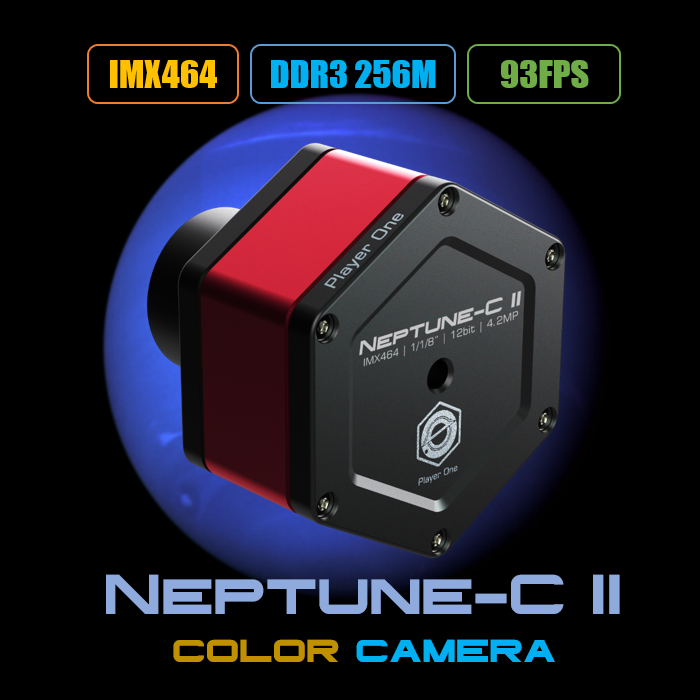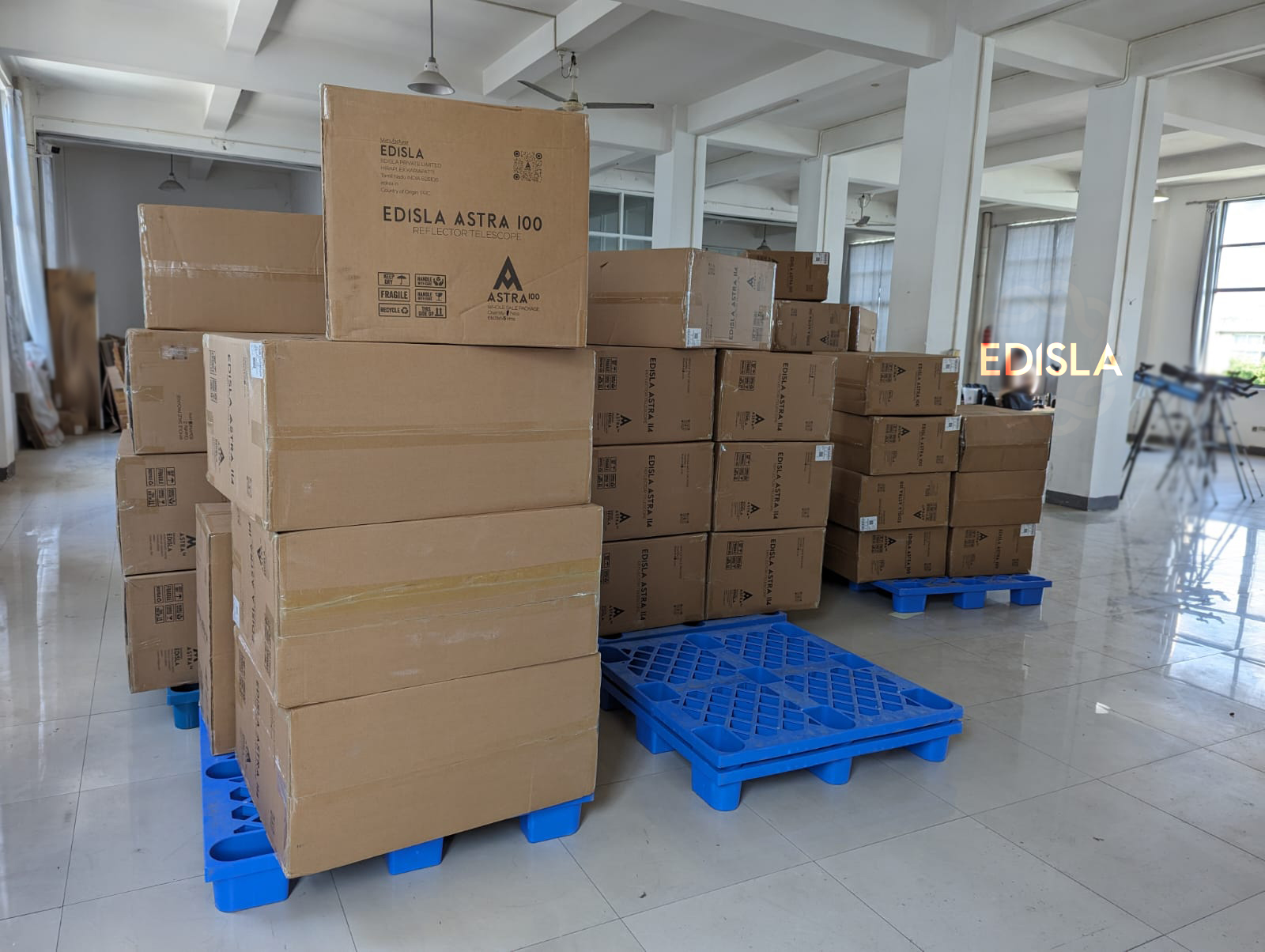Player One Astronomy
Player One Astronomy Neptune-C II USB3.0 Color Camera (IMX464)
Player One Astronomy Neptune-C II USB3.0 Color Camera (IMX464)
In stock
Couldn't load pickup availability
- RazorPay Secure Payment & EMI
- All India Fast & Free Shipping
- Replacement Guarantee
Product Description
Neptune-C II is a planetary camera developed by Player One Astronomy, which adopts the Sony IMX464 1/1.8” format sensor. The 2.9um pixel size accommodates a well depth of 12ke with a total of 4.2MP (the resolution is 2712*1538), and the diagonal is 9mm.

0.7e ultra-low read noise
Compared with the IMX178 of the same frame, the read noise of Neptune-C II can be as low as 0.7e, and the noise is reduced by about 47%, which is as strong as IMX462!

Sensitivity increase
Compared with another 1/1.8 inch chip IMX178, we find that the IMX464 pixel is larger than the IMX178 at 2.4um, reaching 2.9um.

When used on the same telescope, although the quantum efficiency is not much different, the 2.9um pixel has 46% larger photosensitive area than the 2.4um pixel, which can greatly increase the single pixel to obtain more photons, which means Sensitivity has also been greatly improved.

Near infrared super light sensitivity
Not only that, IMX464 also has ultra-sensitive infrared sensitivity characteristics, suitable for playing infrared photography, whether it is matched with IR685, IR850 or CH4 filters, it will give you a new visual experience.

Ultra high frame rate
Neptune-C II can reach 93FPS at full resolution, which is 55% higher than the 60FPS of the IMX178 chip of the same size, making it more efficient to shoot planets.

Highlights
The fun thing is, with the strong ability in capturing infrared lights and the super high sensitivity, the Neptune-C II camera can be used as a monochrome camera with an IR850 filter or CH4 filter to capture infrared lights.
User works appreciation









M82-galaxy-Stephane-Gonza,300F4-newtonian-AND-Neptune-C-II

M27-Sébastien-Kuenlin and Stephane Gonza,Neptune-C-II

galaxy-by-Chi-sheng-Lin Neptune-C II
Connecting the Neptune-C II camera to a telescope with an 1.25″ T-Mount, or adding a Barlow lens between the camera and a telescope to extend the focal length for more details.




With a CS lens attached on the Neptune-C II camera,it can be used as an all-day camera or meteor monitoring camera.

Features:
The naming of Player One Astronomy cameras is unique. For example, we name the planetary cameras after planets (They are Mercury, Venus, Mars, Jupiter, Saturn, Uranus and Neptune, Earth is not included). The size of each planet to a certain extent, represents the size of camera sensors. We will name Saturn with a 1-inch sensor camera, and for Neptune, we will named it with a 1/1.8 inch senor camera. All names will be engraved on the housing of the cameras.

Drivers and softwares download: http://player-one-astronomy.com/service/software/
Manuals download: http://player-one-astronomy.com/service/manuals/
Cutting-edge Design
The planetary cameras developed by Player One Astronomy uses a scientific and technological regular hexagon to construct the main body line, supplemented by round chamfers to achieve both rigidity and flexibility. The positive red, which is like a summer fire, is matched with the low-key and steady black, and the super-fine frosting process on the entire surface makes the camera look luxurious and cool, highlighting the style of high-end players, can’t take my eyes off 😀

2nd Gen – Sensor Tilt Plate
The built-in high-density sponge shading pad can block the light from the side slits without any side leakage.

When taking solar photograph with prominence telescope, the Newton ring is annoying. Smoother solar image without Newton ring could be taken by adjusting the focal plate. Get a much smaller field curvature of the telescope.


256M DDR3 Cache
Player One Astronomy cameras are the first one who adpots the DDR3 cache in all planetary cameras in the world! It helps stabilize and secure data transmission, it effectively avoids frame dropping and greatly reduces readnoise.
With the DDR3 cache, the Mars-C camera does not have high demands on computing needs any longer, it will still has excellent performance even if it is connected to a USB 2.0 port.

DPS technology
The planetary cameras from Player One Astronomy have DPS (Dead Pixel Suppression) technology. The DPS is anaylse many dark frames to find out thoes fixed abnormal pixel and record the map in camera memory. In imaging, each exposure frames, thoes position of dead pixels will be given a median value according to the active pixels around that abnormal pixel.

Overvoltage and overcurrent protection mechanism
Player One cameras produced by the number one player ensures the safety of your camera and other equipment through overvoltage and overcurrent protection mechanisms.
Data Port
When the camera is connected to the USB3.0 interface and full-resolution preview is used, it can reach 93 FPS in RAW8 mode (10bit ADC). When recording images, since the actual writing speed will be affected by the writing speed of the hard disk itself, when the hard disk writing speed is slow, the recording may not reach the theoretical speed. It is recommended that you use a high-quality solid state drive to record data to give full play to the performance of the camera.
Use the ST4 guide cable to connect the camera and the AUTO GUIDE port of the equatorial mount to do guiding.

Performance

Readout Noise
Regarding readout noise, we solemnly promise that all values are obtained from actual tests. And for users, you could use Sharpcap 4 for testing. SC4 has a function called Sensor Analysis, provide a very simple way to test readout noise.
We wrote a tutorial on our website: https://player-one-astronomy.com/service/manuals/
After many rigorous readout noise tests, the Neptune-C II camera can reach a low readout noise of 0.75e at a gain of 350 and around 0.71e at a gain of 400.
If you are interested in readout noise testing, you may try it yourself, which is very simple.
HCG Mode
The Neptune-C II camera has a unique HCG mode, which will automatically turn on when the camera gain setting is ≥83. The HCG mode can greatly reduce the readout noise and retain the same high dynamic range as the low gain.
Mechanical Drawing


EDISLA Pre-Order: Source Anything

Research It
Find the product you want.

Talk to Us
Get expert guidance fast.

We Source It
Delivered within 4 weeks.

Enjoy It
Be happy with your gear.
Got a question?
what we get asked most often
Are the prices all-inclusive?
Yes. The price you see is the price you'll pay. All taxes are included. Free shipping on all orders.
What's the stock status of the products on your site?
We list only in-stock items on our website that can be shipped right away. Sold out products are out of stock, so you can't place an order.
Selected products are available for Preorder, with a guaranteed delivery within 30 days or your money back.
How fast do you ship?
We process and ship all orders within two business days. Shipping time is determined by the speed of the shipping partner.
Is there a guarantee on your products?
Yes. On top of the manufacturer's warranty, we also offer a Replacement Guarantee on all online orders. In the event that the product is defective or damaged during shipping, you will receive a replacement.
Can I cancel my order?
We'll refund you 90% if you cancel before dispatch. Cancellations after dispatch are complicated. Take a look at the our Policy here
What's your return policy?
We have strict return/refund policies as a company that deals with fragile products. Casual returns are not permitted. Items that are not damaged in transit or defective cannot be returned.So please take a moment to review our Refund Policy.
Could I order something that's out of stock or not listed?
If you are interested in ordering an out-of-stock item, click the "notify me" button. You will be notified when the item is back in stock.
To source a specific product for you, our team needs more information. Specific orders will be subject to case-by-case terms and conditions.





